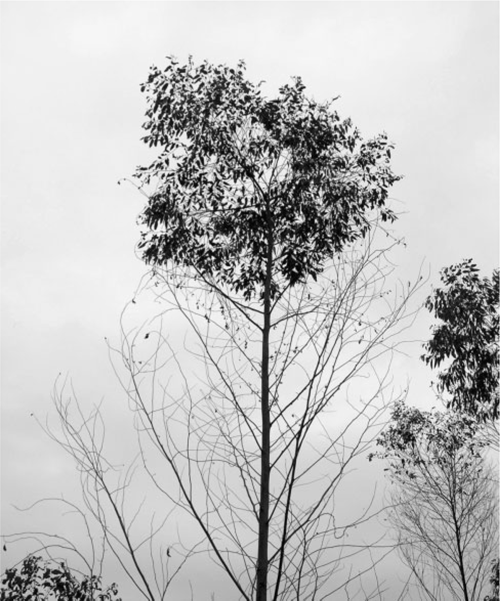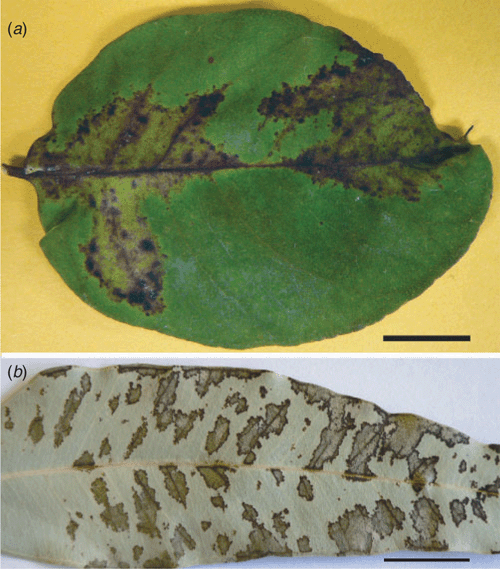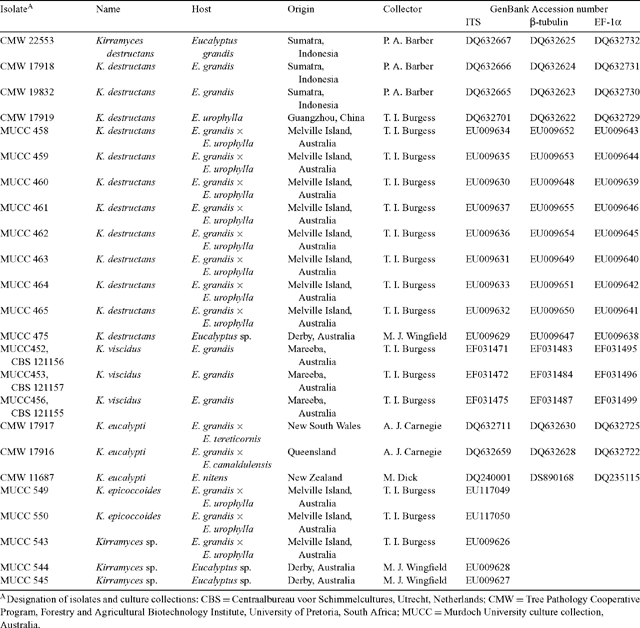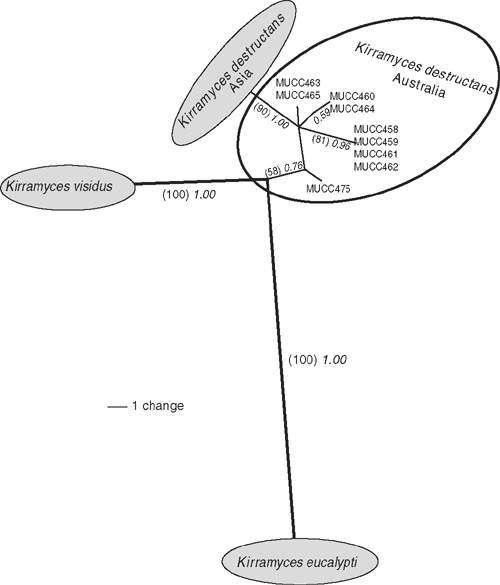The eucalypt leaf blight pathogen Kirramyces destructans discovered in Australia
T. I. Burgess A B C , V. Andjic A , M. J. Wingfield B and G. E. St. J. Hardy AA Biological Science, Murdoch University, South Street, Murdoch 6150, Australia.
B Forestry and Agricultural Biotechnology Institute (FABI), University of Pretoria, Pretoria 0002, South Africa.
C Corresponding author. Email: tburgess@murdoch.edu.au
Australasian Plant Disease Notes 2(1) 141-144 https://doi.org/10.1071/DN07056
Submitted: 16 August 2007 Accepted: 10 September 2007 Published: 26 September 2007
Abstract
Kirramyces destructans is a serious pathogen causing a leaf, bud and shoot blight disease of Eucalyptus species in plantations of the subtropics and tropics of South East Asia. This pathogen was first discovered in Indonesia in 1995 and has subsequently spread to Thailand, China and Vietnam. Kirramyces destructans is not known to occur in Australia and has been considered a major biosecurity threat. During the course of the past four years, surveys have been conducted in existing eucalypt trials in tropical Australia. Several Kirramyces spp. were detected in these surveys, including isolates with morphological and cultural characteristics resembling those of K. destructans. In this study, DNA sequences of three gene regions were used to compare isolates of Kirramyces spp. emerging from the surveys and these were compared with those of K. destructans and the closely related K. eucalypti and K. viscidus. Results have shown, for the first time, that K. destructans is present in northern Australia (Melville Island, Northern Territory and Derby, Western Australia). The observed sequence variation among a small number of isolates also strongly suggests K. destructans is endemic to Northern Australia.
Kirramyces destructans is an aggressive pathogen first reported causing disease on 1–3-year-old E. grandis in Sumatra, Indonesia (Wingfield et al. 1996). Since then it has been detected in Thailand, China and Vietnam. In these countries it has been found on E. grandis as well as E. camaldulensis and E. urophylla and various hybrids between the three species (Old et al. 2003a, 2003b; Barber 2004; Burgess et al. 2006). Kirramyces destructans has also been reported from native E. urophylla in East Timor (Old et al. 2003a).
Symptoms of infection by K. destructans include distortion of infected leaves and blight of young leaves, buds and shoots. The pathogen causes severe defoliation of juvenile leaves on trees in plantations (Fig. 1) and infection of young tissue on clonal mother plants in production nurseries can seriously affect productivity. The pathogen has never been found in Australia, where most Eucalyptus spp. are native, but its discovery in East Timor, where E. urophylla occurs naturally (Old et al. 2003a), suggested this country might represent the area of origin of K. destructans. As such, K. destructans could have moved into South East Asia on infected germplasm from the substantial collections of E. urophylla from Timor. Due to the devastating impact that K. destructans could have on eucalypt plantations and native forests in Australia, this pathogen has been listed on the Plant Biosecurity Watch List for Australia (http://www.daff.gov.au, verified 12 September 2007).

|
During the course of the last four years, we have been studying the population diversity and distribution of K. destructans in Asia and the biosecurity threat this pathogen might pose to eucalypt plantations and forests in Australia. As part of this project, surveys have been conducted in Northern Australia, using existing trials of non-endemic eucalypts as sentinel plantings and by evaluating these trials for disease caused by Kirramyces spp. A new species, Kirramyces viscidus, which is closely related to K. destructans, was discovered in a taxa trial in Northern Queensland (Andjic et al. 2007b).
Juvenile eucalypt leaves with symptoms resembling those of K. destructans (Fig. 2a) were collected in July 2006 from a clonal taxa trial on Melville Island, 50 km off the coast from Darwin, Northern Territory, Australia. The trees had been severely damaged by cyclone Ingrid in March 2006 and they were coppiced approximately 2 months later. The abaxial surfaces of the leaves were covered with pycnidia, exuding conidia resembling those of various species including K. destructans, K. eucalypti and K. epicoccoides. Adult leaves were also collected from a mature tree of an unknown Eucalyptus sp. at the Kimberly Entrance caravan park in Derby, Western Australia (Fig. 2b). Although the symptoms on these leaves were not typical of K. destructans, this material was studied because the conidia were similar to those of the pathogen.

|
Isolations from conidia taken from leaves of trees on Melville Island and those from Derby were made as described previously (Andjic et al. 2007b). Cultural characteristics of several isolates were the same as those of K. destructans, with white to pink colonies producing black spore masses on the upper surface and olive-green to black at the centres on the reverse sides of the plates. All isolates have been maintained in the culture collection of Murdoch University (MUCC) (Table 1).

|
Genomic DNA was extracted from cultures as described previously (Andjic et al. 2007c). Initially, the second internal transcribed spacer and part of 5.8 S region of the rDNA (ITS2) was amplified and sequenced for all Kirramyces isolates. For those isolates with sequence data similar or identical to K. destructans, the β-tubulin (BT) and translation elongation factor 1α (EF-1α) gene regions were amplified and sequenced as previously described (Andjic et al. 2007c). Parsimony analyses were performed on the combined datasets in PAUP (Phylogenetic Analysis Using Parsimony) version 4.0b10 (Swofford 2003) and Bayesian analysis was made using MrBayes (Ronquist Heuelsenbeck 2003) following the methods described by (Andjic et al. 2007c). Sequence data for isolates collected from northern Australia were compared with those for K. destructans from Asia and the closely related species K. eucalypti and K. viscidus (Andjic et al. 2007a, 2007b).
K. epicoccoides and three undescribed Kirramyces spp. were found among isolates from Melville Island and Derby (Table 1). Nine isolates with an ITS2 profile similar to that of K. destructans were retained for further analysis. In both parsimony and Bayesian analyses, K. eucalypti was distant from K. destructans and K. viscidus, forming a clade with 100% bootstrap support (parsimony analysis) and a posterior probability of 1.0 (Bayesian) (Fig. 3). Although related to K. destructans, isolates of K. viscidus resided in a clade discrete from those of K. destructans (Fig. 3).

|
Isolates of K. destructans from Asia grouped together, but were most closely related to those from Melville Island and the single isolate from Derby. There was only 1 bp difference in BT and EF-1α sequences between the K. destructans isolates from Asia and those from Australia. ITS2 sequence data showed the greatest amount of variation with up to 4 bp difference between Asian isolates and some of the Australian isolates. Thus, from ~1000 bp of sequence, the maximum difference among isolates was 6 bp. This is within the normal limits of intraspecies variation and justifies the identification of the Australian isolates as K. destructans.
The observed symptoms on leaves, conidial morphology, culture characteristics and multilocus sequence data lead us to conclude K. destructans is present in Australia. Variability amongst isolates from Melville Island suggests K. destructans is endemic to the region. This information has been provided to Biosecurity Australia and we believe it is appropriate to remove K. destructans from the Biosecurity Australia Watch List for eucalypt pathogens. Although, regular surveys have been conducted in northern Queensland and K. viscidus, K. epicoccoides, K. eucalypti and several, as yet, undescribed Kirramyces spp. have been isolated (unpubl. data), we have not irrefutably detected K. destructans in this region. Due to the potential impact of this pathogen on eucalypt plantations in tropical Australia, it is essential that monitoring in this region is maintained.
Acknowledgements
This work was funded in part by the Australian Research Council DP0664334, ‘Biosecurity of Australia’s eucalypts at risk from exotic fungal diseases present in the Asian region’. Vera Andjic received a Murdoch University Doctoral Research Scholarship to undertake this and related studies. We thank Dianne White for technical support and Great Southern Limited for allowing us access to their trials on Melville Island. We would also like to thank the Queensland Department of Primary Industries and Fisheries for access to trial plantations in northern Queensland which have been surveyed in conjunction with Mr Geoff Pegg and Dr Angus Carnegie.
Andjic V,
Barber PA,
Carnegie AJ,
Hardy GEStJ,
Wingfield MJ, Burgess TI
(2007a) A morphological and phylogenetic reassessment of the genus Phaeophleospora and the resurrection of the genus Kirramyces. Mycological Research in press ,

Andjic V,
Barber PA,
Carnegie AJ,
Pegg G,
Hardy GEStJ,
Wingfield MJ, Burgess TI
(2007b) Kirramyces viscidus sp. nov., a new eucalypt pathogen from tropical Australia is closely related to the serious leaf pathogen, Kirramyces destructans. Australasian Plant Pathology 36, 478–487.
| Crossref |

Andjic V,
Cortinas M-N,
Hardy GEStJ,
Wingfield MJ, Burgess TI
(2007c) Multiple gene genealogies reveal important relationships between species of Phaeophleospora infecting Eucalyptus leaves. FEMS Microbiology Letters 268, 22–33.
| Crossref | GoogleScholarGoogle Scholar | PubMed |

Barber PA
(2004) Forest Pathology: the threat of disease to plantation forests in Indonesia. Plant Pathology Journal 3, 97–104.

Burgess TI,
Andjic V,
Hardy GEStJ,
Dell B, Xu D
(2006) First report of Phaeophleospora destructans in China. Journal of Tropical Forest Science 18, 144–146.

Ronquist F, Heuelsenbeck JP
(2003) MrBayes 3: Bayesian phylogenetic inference under mixed models. Bioinformatics 19, 1572–1574.
| Crossref | GoogleScholarGoogle Scholar | PubMed |

Wingfield MJ,
Crous PW, Boden D
(1996) Kirramyces destructans sp. nov., a serious leaf pathogen of Eucalyptus in Indonesia. South African Journal of Botany 62, 325–327.



